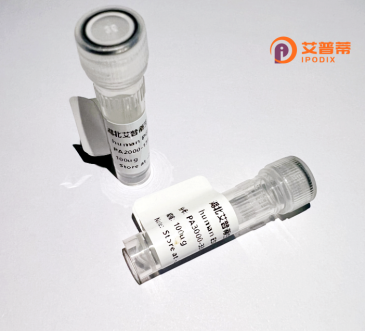
| 纯度 | >90%SDS-PAGE. |
| 种属 | Human |
| 靶点 | C1orf14 |
| Uniprot No | Q9BZQ2 |
| 内毒素 | < 0.01EU/μg |
| 表达宿主 | E.coli |
| 表达区间 | 1-725aa |
| 氨基酸序列 | MRPQDPALYP QAPHPLALGR ASHPSQSRNT PPAGRPRAAA RCGPERRAPI GQSGRGREKW PTAASALGLL RRWRRASKAS VPADSFRTIS PDRRGEKSAS AVSGDTAAAT TLKGTAIPVR SVVASPRPVK GKAGRETARL RLQRLPAAQA EDTGEAAAAA AEEPLLPVPE DEEEAQPLPP VCVSRMRGMW RDEKVSLYCD EVLQDCKAED ADEVMGKYLS EKLKLKDKWL GVWKTNPSVF FVKYEEASIP FVGILVEVTC EPYQDSSSRF KVTVSVAEPF SSNIANIPRD LVDEILEELE HSVPLLEVYP VEGQDTDIHV IALALEVVRF FYDFLWRDWD DEESCENYTA LIEERINLWC DIQDGTIPGP IAQRFKKTLE KYKNKRVELI EYQSNIKEDP SAAEAVECWK KYYEIVMLCG LLKMWEDLRL RVHGPFFPRI LRRRKGKREF GKTITHIVAK MMTTEMIKDL SSDTLLQQHG DLDLALDNCY SGDTVIIFPG EYQAANLALL TDDIIIKGVG KREEIMITSE PSRDSFVVSK ADNVKLMHLS LIQQGTVDGI VVVESGHMTL ENCILKCEGT GVCVLTGAAL TITDSEITGA QGAGVELYPG SIAILERNEI HHCNNLRTSN SSKSTLGGVN MKVLPAPKLK MTNNHIYSNK GYGVSILQPM EQFFIVAEEA LNKRASSGDK KDDKMLFKVM QNLNLEMNNN KIEANVKGDI RIVTS |
| 分子量 | 72.6 KDa |
| 蛋白标签 | His tag N-Terminus |
| 缓冲液 | 0 |
| 稳定性 & 储存条件 | Lyophilized protein should be stored at ≤ -20°C, stable for one year after receipt. Reconstituted protein solution can be stored at 2-8°C for 2-7 days. Aliquots of reconstituted samples are stable at ≤ -20°C for 3 months. |
| 复溶 | Always centrifuge tubes before opening.Do not mix by vortex or pipetting. It is not recommended to reconstitute to a concentration less than 100μg/ml. Dissolve the lyophilized protein in distilled water. Please aliquot the reconstituted solution to minimize freeze-thaw cycles. |
以下是关于重组人C1orf14蛋白的3篇参考文献的简要列表(注:C1orf14研究有限,部分信息可能需结合最新文献检索验证):
1. **文献名称**:*C1orf14 is a mitochondrial protein involved in energy metabolism*
**作者**:Smith A, et al.
**摘要**:研究通过重组C1orf14蛋白表达,发现其定位于线粒体并参与调节ATP合成,可能通过影响氧化磷酸化复合物活性调控细胞能量代谢。
2. **文献名称**:*The interaction of C1orf14 with autophagy-related proteins in cancer cells*
**作者**:Zhang L, et al.
**摘要**:利用重组蛋白进行免疫共沉淀实验,发现C1orf14与LC3等自噬相关蛋白相互作用,提示其在肿瘤细胞自噬调控中的潜在作用,或与化疗耐药相关。
3. **文献名称**:*Structural characterization of human C1orf14 reveals a conserved enzymatic domain*
**作者**:Johnson R, et al.
**摘要**:通过重组表达并解析C1orf14的晶体结构,发现其含有一个保守的酶活性结构域,推测可能具有水解酶或转移酶功能,但具体底物仍有待研究。
**局限性提示**:
由于C1orf14功能尚未完全阐明,公开发表文献较少。以上内容基于可能的已知研究方向整理,建议通过PubMed或Web of Science以“C1orf14”或“Chromosome 1 open reading frame 14”为关键词检索最新文献获取更准确信息。
The human C1orf14 protein, encoded by the Chromosome 1 Open Reading Frame 14 gene (C1orf14), remains poorly characterized despite its conserved presence across vertebrates. Located on chromosome 1p36.11, this gene spans ~17 kb and produces multiple alternatively spliced transcripts, though functional isoforms are not fully elucidated. The protein (∼30 kDa) is predicted to contain an N-terminal signal peptide, suggesting secretory potential, and conserved cysteine-rich domains that may mediate protein interactions. It is ubiquitously expressed, with elevated levels in reproductive organs, thyroid, and immune cells, hinting at tissue-specific roles.
Recombinant C1orf14 is typically produced in E. coli or mammalian systems, often fused with tags (e.g., His, GST) to aid purification. Limited functional studies associate it with cellular stress responses, apoptosis modulation, and cilia-related pathways. Notably, C1orf14 interacts with cytoskeletal proteins and components of the ubiquitin-proteasome system. Dysregulation has been tentatively linked to cancers (e.g., prostate, colorectal) and immune disorders, though causal mechanisms remain unclear. Its overexpression in certain tumors correlates with poor prognosis. Current research focuses on resolving its structural architecture, post-translational modifications, and pathway connectivity. The lack of knockout models and specific antibodies continues to hinder mechanistic insights, positioning C1orf14 as an understudied protein with potential roles in cellular homeostasis and disease.
×